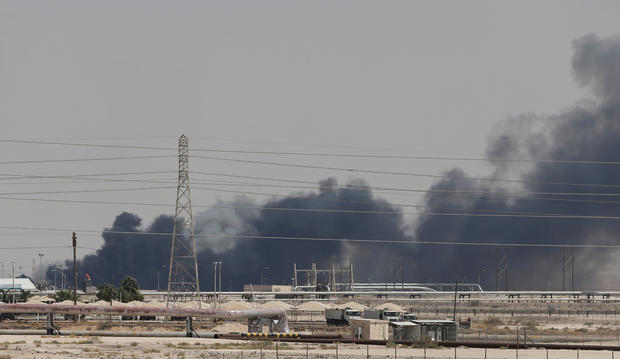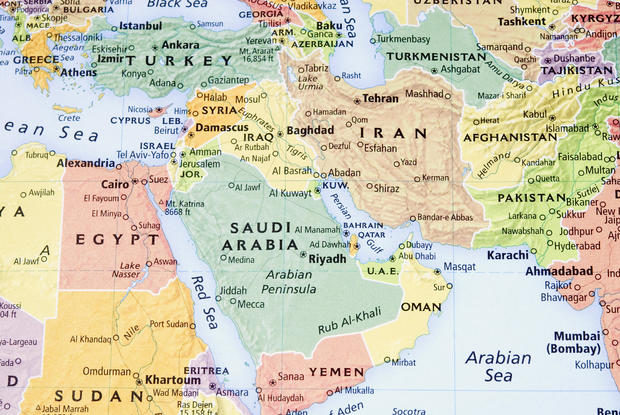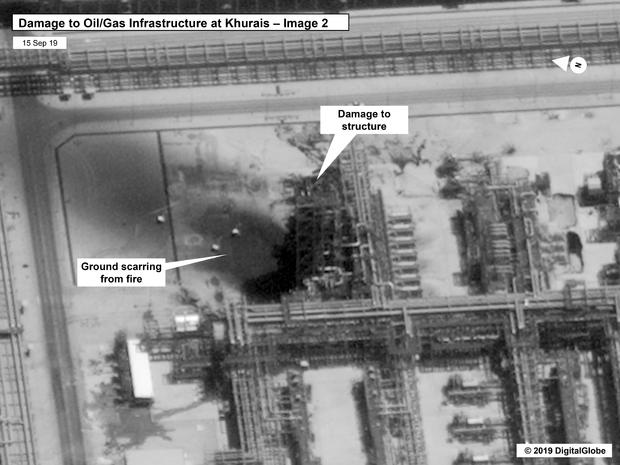US blames Iran for Saudi oil attack
Dubai, United Arab Emirates -Global energy prices spiked on Monday after a weekend attack on key oil facilities in Saudi Arabia caused the worst disruption to world supplies on record. President Trump has warned the U.S. is “locked and loaded” to respond as two of his cabinet members blame the attack on Iran.
U.S. officials offered satellite images of the damage at the heart of the kingdom’s crucial Abqaiq oil processing plant and a key oil field, alleging the pattern of destruction suggested the attack on Saturday came from either Iraq or Iran – rather than Yemen, as claimed by Iranian- backed Houthi rebels there.
Iran for its part called the US allegations “maximum lies” and denied any role in the attack on the Saudi facilities.
Actions on any side could break into the open a twilight war that’s been raging just below the surface of the wider Persian Gulf in recent months.
Already, there have been mysterious attacks on oil tankers that America blames on Tehran, at least one suspected Israeli strike on Shiite forces in Iraq, and Iran has shot down a US military surveillance drone.
Crude spikes, then settles up 10%
Benchmark Brent crude gained nearly 20 % in the first moments of trading Monday before settling down to 10% higher as trading continued. A barrel of Brent traded up $ 6 to $ 66. 28.
US benchmark West Texas crude was up around 9%. U.S. gasoline and heating oil similarly were up over 8% and 7% respectively before markets opened in New York.

Saturday’s attack halted production of 5.7 million barrels of crude a day, more than half of Saudi Arabia’s global daily exports and more than 5% of the world daily crude oil production . Most of that output goes to Asia.
At 5.7 million barrels of crude oil a day, the Saudi disruption would be the greatest on record for world markets, according to figures from the Paris-based International Energy Agency. It just edges out the 5.6 million-barrels-a-day disruption around the time of Iran 1979 Islamic Revolution, according to the IEA.
Reaching into the reserves?
Saudi Arabia has pledged that its stockpiles would keep global markets supplied as it rushes to repair damage at the Abqaiq facility and its Khurais oil field.
The Trump administration, Meanwhile, said it wasprepared to tap the US Strategic Petroleum Reserve“if needed” to maintain a consistent supply and prevent a massive price hike. The Reserve is a stockpile of about 630 million barrels of crude, maintained by the Department of Energy, to deploy precisely for the purpose of mitigating fluctuations in the global oil supply.
A statement from DOE Press Secretary Shaylyn Hynes, written just hours after the attack on the Saudi facility, said the agency “stands ready to deploy resources from the Strategic Petroleum Oil Reserves (SPRO) if necessary to offset any disruptions to oil markets as a result of this act of aggression. “
Mr. Trump said in a series of tweets that he had also, “informed all appropriate agencies to expedite approvals of the oil pipelines currently in the permitting process in Texas and various other States,” to try to increase domestic U.S. production.
“Locked and loaded”
Mr. Trump said the U.S. had reason to believe it knows who was behind the attack – his secretary of state had blamed Iran the previous day. He assured his Twitter followers that “we are … locked and loaded” depending on verification and were waiting to hear from the Saudis as to who they believe was behind the attack and “under what terms we would proceed!”
Energy Secretary Rick Perry also put the blame squarely on Iran Monday. Perry said in a tweet that the global oil market was “resilient and will respond positively” to measures by the U.S. to prevent a long-term price rise due to what he called “Iran attack on the global economy and energy markets.”
“The United States wholeheartedly condemns Iran attack on the Kingdom of Saudi Arabia. We call on other nations to do the same,” Perry said at a conference of the International Atomic Energy Agency in Vienna, Austria. “This behavior is unacceptable and they must be held responsible.”
(The Department of) @ ENERGYstands ready to release oil from the SPR deemed sufficient to offset Iran attack on the global economy and energy markets. The market is resilient and will respond positively!https://t.co/gyh2YSzasC– Rick Perry (@SecretaryPerry) (September) , 2019
But there was less certainty from London, where British Foreign Secretary Dominic Raab called the attack “a wanton violation of international law,” but said it was still “not entirely clear” who was to blame.
“I want to have a very clear picture, which we will be having shortly, “Raab said. “It’s a very serious, an outrageous act, and we need to have a clear and as united as possible international response to it.”
The Houthi rebels in Yemen reiterated their claim of responsibility, meanwhile, and warned Monday that they could attack Saudi infrastructure again “at any moment.”
“We assure the Saudi regime that our long military arm can reach wherever we want, at the time we set,” a spokesman for the Houthi military command said in a message sent via social media. The message demanded the Saudi government halt its “aggression and siege on Yemen.”
Mr. Trump’s tweets followed a National Security Council meeting at the White House that included Vice President Mike Pence, Secretary of State Mike Pompeo and Defense Secretary Mark Esper.
A US official said all options, including a military response, were on the table, but said no decisions had been made Sunday. The official spoke on condition of anonymity to discuss the internal deliberations.

Mr. Trump’s “locked and loaded” comment mirrors similar remarks he made following Iran shooting down a U.S. military surveillance drone in June. However, the presidentsaid he pulled back from retaliatingagainst Iran at the last minute.
US officials also offered highly detailed satellite photos of the Saudi sites that show damage suggesting the attack came from the north, where Iran or Iraq are, rather than from Yemen to the south. Iraqi prime minister has denied the attack came from his country, whereIranian-backed Shiite rebels operate.
Iranian Foreign Ministry spokesman Abbas Mousavi on Sunday dismissed the US allegations as “blind and futile comments.”
“The Americans adopted the ‘maximum pressure’ policy against Iran, which, due to its failure, is leaning toward ‘maximum lies,'” Mousavi said.
The US satellite photos appear to show the attack on Abqaiq may have struck the most-sensitive part of the facility, its stabilization area.

The Washington-based Center for Strategic and International Studies has said the area includes “storage tanks and processing and compressor trains – which greatly increases the likelihood of a strike successfully disrupting or destroying its operations. “
Stabilization means processing so-called sour crude oil into sweet crude. That allows it to be transported onto transshipment points on the Persian Gulf and the Red Sea, or to refineries for local production.







GIPHY App Key not set. Please check settings